There are many ways to heat a private home using gas and electricity. However, it is also a proven option using solid fuel stoves. Using stove heating in its classic form with the transfer of heat into the air from the walls of the stove is effective only for small rooms. For uniform and rapid distribution of heat, heating circuits are used, where air or water is used as a heat carrier.
The reason for the stable preference that the owners of private houses give to the stove heating option is the cheapness and availability of firewood, fuel briquettes or coal.
The disadvantage is the limited space to be treated, which can be eliminated by arranging a water and air system based on a brick aggregate.
The main disadvantage of stove heating is the limited space to be processed. A device based on a stove of water and air circuits will provide heat supply to rooms remote from it
The principle of operation of air heating based on a stove or fireplace is to transfer a warm stream heated to operating temperature in a heat exchanger or in a boiler. Air enters either directly into the room or through air ducts. Due to the relatively short path, it does not have time to lose temperature. The result is an even distribution of heat throughout the house.
A chamber for heating the air is arranged above the firebox so that the hot upper surface of the firebox and the chimney transfer the maximum amount of heat to it. Air circulation takes place naturally or with the help of fans.
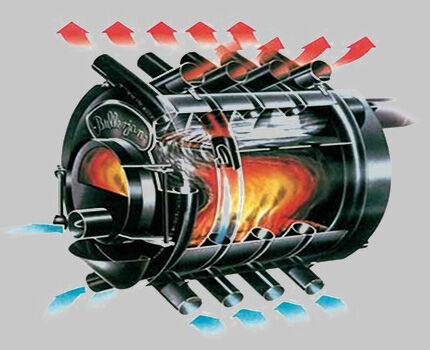
A factory-made steel furnace for heating a room with an area of 120 square meters using air flows costs about 12,000 rubles
Natural circulation occurs as a result of the difference in density between cold and hot air. Cold air entering the heating chamber displaces hot air into the air ducts. This method does not require the presence of electricity, however, if the air does not move quickly enough through the heating chamber, it becomes very hot, which can cause problems.
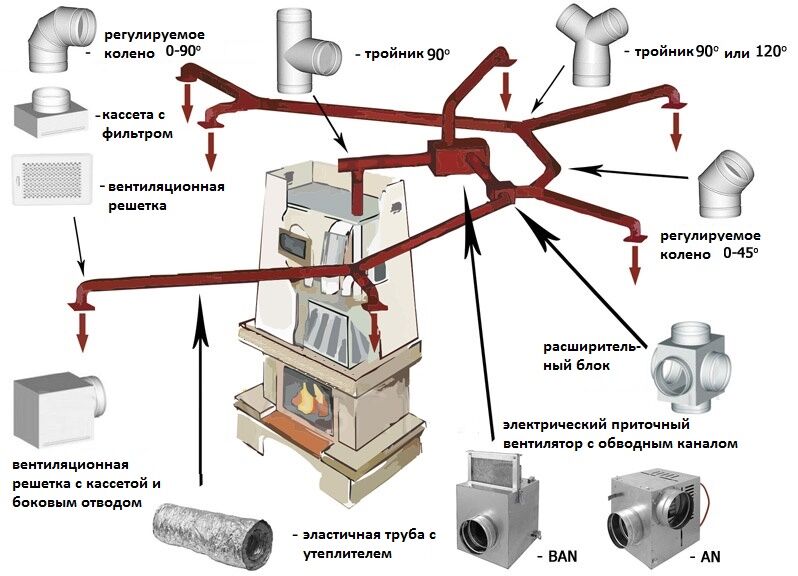
Air heating with natural movement of heated air involves the installation of ducts for directional movement. In forced versions, the air movement is stimulated by the fan (+)
Forced circulation takes place using fans or pumps. However, premises are heated more quickly and evenly. With forced ventilation, by adjusting its mode, you can easily control the volume of air supplied to various rooms, thereby determining the microclimate of individual rooms in the house.
By the type of cold air supply, the systems are divided into two types:
- Fully recirculated. Heated air masses alternate with cooled air masses within the same room. The downside to this scheme is that air quality drops with each heating / cooling cycle.
- With partial reclamation. Part of the fresh air is taken from the street, which is mixed with part of the air from the room. After heating, the mixture of two air portions is delivered to the consumer. Advantage in stable air quality, disadvantage in volatility.
It is clear that the first group includes duct systems with natural movement of the air coolant. The second includes options with forced air movement, for the movement of which it is not necessary to arrange a network of air ducts.
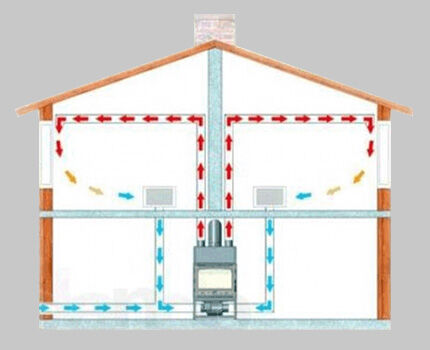
Air inflow from the outside gives the system with natural circulation an additional impulse, which eliminates the need for fans
The main advantages of air heating in comparison with water heating:
- high efficiency;
- trouble-free;
- lack of radiators in the premises.
The design of a forced-motion circuit makes it possible to dispense with the construction of an air duct system. In addition, this type can be combined with air conditioning, humidification and air ionization.
The main disadvantages of air heating in comparison with water heating:
- when using a furnace, the temperature of the supplied air has a significant range, in contrast to the use of other heating means;
- air ducts have a large diameter, therefore, installation must be carried out at the construction stage;
- the location of the stove in the basement is desirable, otherwise it is necessary to use fans that make noise.
The movement of air in the room has a negative side - it raises dust, however, the use of filters at the exit from the duct allows you to effectively trap this dust, thus reducing the total amount of dust in the house.
Another feature of air heating, which has a positive and negative side, is the rate of heat transfer. On the one hand, the rooms heat up faster than when heating with a water circuit, on the other hand, there is no thermal inertia - as soon as the stove or fireplace goes out, the room immediately begins to cool down.
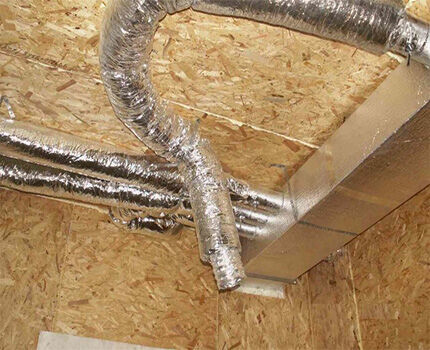
To ensure uniform pressure in the lateral branches of the air duct, it is necessary to exclude their insertion into the last half meter of the main air duct
Unlike water heating, the installation of an air heating system is not difficult. All elements (pipes, bends, ventilation grilles) can be connected quite simply without welding. There are flexible air ducts that can take any shape, depending on the geometry of the premises.
Despite this, air heating systems based on stoves or fireplaces have not yet become widespread. Much more often in individual low-rise construction, a water circuit is used to heat premises.
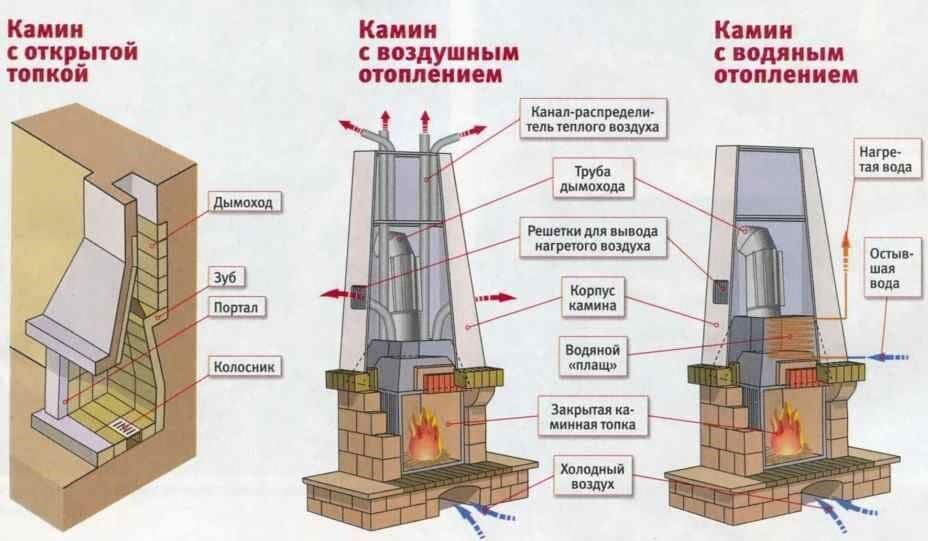
On the basis of a stove or fireplace with a brick or steel firebox, you can arrange both air and water heating (+)
Furnace-based hot water heating device
The principles of operation of any water heating are based on the distribution of heat from a local source throughout the room, using the movement of water along the heating circuit.
The main elements of water heating
For a furnace heating scheme with a water circuit, the main elements are:
- stove or fireplace with a heat exchanger in which water is heated;
- heating circuit, where heat is transferred to the room;
- expansion tank to prevent damage to the system as a result of pressure build-up;
- circulation pump to ensure the movement of water along the circuit.
There are general rules for the operation of hot water heating, such as wiring diagrams, which are well known and must be followed. However, when using a stove as a heat source, there are specific requirements associated with the peculiarity of the temperature regime.
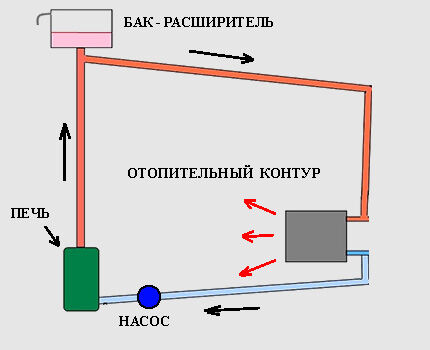
The principle of operation of water heating based on a stove or fireplace is simple, but it is necessary to accurately calculate the parameters of all elements of the system
The stoves do not heat up quickly and cool down slowly, there is an uneven heat generation and only the correct installation of all system components will avoid problems with high-quality heating of the premises of the house.
Types of heat exchanger and placement methods
For the manufacture of a heat exchanger for furnaces, sheet "black" steel or heat-resistant stainless steel is used. The use of cast iron as a material for production is difficult, but finished cast iron products such as cast iron radiators can be used.
It is possible to use copper, which has better thermal conductivity than steel, but the price of such a device will be high. The heat exchanger is recommended to be made of steel with a thickness of 3 mm. At high furnace temperatures, arising in the case of using coal or, even more so, coke, it is necessary to use steel with a thickness of 5 mm.
Heat exchangers can be conditionally divided into three types:
- registers, coils and radiators, consisting of a set of pipes;
- shirts (boilers) welded from sheet steel;
- a combined version in the form of vertical walls connected by pipes (the so-called "books").
Sheet steel jackets are easier to manufacture and easier to clean from combustion products, but tubular structures have a larger heating area. When making a jacket, it is necessary to take into account the excess water pressure that occurs when using a membrane expansion tank or raising water to a great height.
In this case, it is required to use steel with a thickness of at least 5 mm and additionally reinforce the walls with stiffeners to avoid deformation.
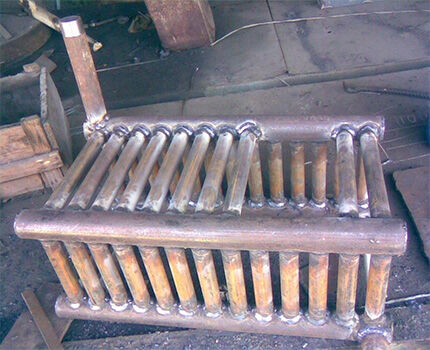
The more ribs in the register placed in the furnace, the higher the rate of heat transfer between water and hot air in the furnace.
The shapes of tubular structures can be different, however, it is necessary to comply with the condition that the internal size of the pipes is at least 3 cm in diameter. Otherwise, water may boil if the circulation is slow or the temperature is too high. Registers are made, as a rule, from shaped, and not from round pipes in order to facilitate welding work.
You can make a heat exchanger of the required size yourself. In this case, increased attention should be paid to the quality of welding. If a leak occurs in the heat exchanger, all the water will pour into the oven. In addition, to eliminate the problem, a large amount of work will have to be done: disassemble the stove, remove, weld and put back the heat exchanger, and then reassemble the stove.
There are two options for the location of the heat exchanger. In the first case, it is placed directly in the firebox, significantly narrowing its space. In the second case, the registers are installed in the bell of non-rotating furnaces, but the furnace itself in this case has a more complex design.
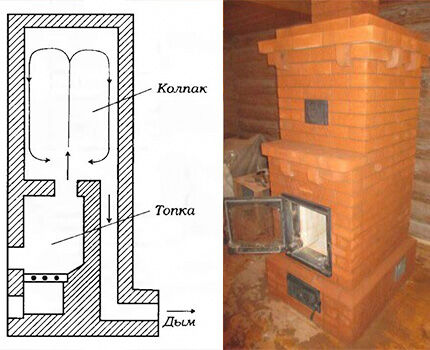
In the presence of a bell-type furnace, it is better to place the heat exchanger in a bell: it is also hot there, and the space of the firebox will remain unchanged.
When installing a tubular type heat exchanger, it is necessary to leave a gap between it and the wall of the stove. This is necessary for better heating of the coolant, as well as the possibility of cleaning the register. It is necessary to periodically clean both shirts and registers, since in the case of severe clogging with ash, the efficiency of heat transfer decreases.
If a hob is present, cleaning takes place after removing it. If the stove has only a heating function, then cleaning takes place through the fire door.
Water circulation in the heating circuit
The basic principles of organizing the natural circulation of water in the system are to simulate the "acceleration collector" at the outlet of the heat exchanger and to create a constant slope of the heating circuit pipes of 3-5 degrees. The general meaning of the "runaway collector" is that the heated water from the stove rises vertically upward, and then it is already distributed along the heating circuit.
Circulation occurs due to the difference in the specific gravity of cold and hot water. Cold water is heavier than hot water, and flowing to the heat exchanger displaces hot water up the pipe. The entry point of the "return" must be lower than the water outlets from the heating radiators, otherwise the water circulation will be very slow or not at all.
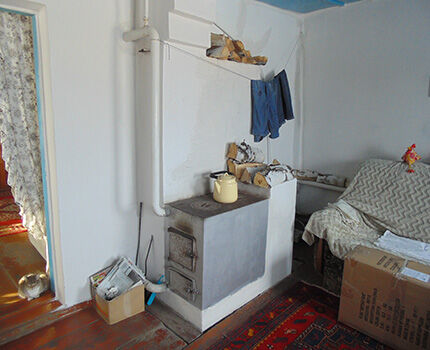
The acceleration manifold is necessary even for small heating circuits in the case of using natural circulation
The installation of circulation pumps increases the speed of movement of water along the heating circuit and, thus, a faster and more even distribution of heat throughout the house. Several pumps can be used at the same time for different heating circuits.
In the event of power surges, a voltage stabilizer must be used, since failure of the pump can lead to serious consequences for the entire system. Pumps can be conditionally divided into two types with respect to the position of the engine: with a "dry" rotor and a "wet" rotor, and into two types in terms of voltage: they can operate from a 220 Volt network and from a 12 Volt power source.
The motor in pumps with "dry" rotor is isolated from the impeller immersed in water by O-rings. Compared to pumps with a submerged motor, dry pumps have a higher efficiency. However, among the disadvantages can be called a high noise level, the need for regular maintenance and a shorter engine life. Therefore, in a private house, as a rule, circulating pumps with a "wet" rotor are used.
The choice of the type of pump power supply depends on the possibility of natural circulation of water in the system. If it is not possible without the participation of the pump, then the choice should be made in favor of the option with support for 12 Volts and an uninterruptible power supply.
Otherwise, in the event of a power outage, water may boil and the system may fail. If natural circulation is possible, then it is better to purchase a more widespread and cheaper option with a 220 volt mains supply.
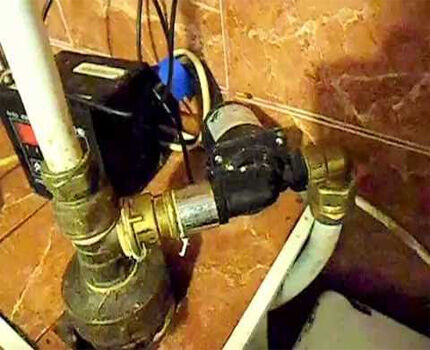
By connecting a pump with a voltage of 12 volts to an uninterruptible power supply, you can not worry about the functioning of the heating system
When installing a pump with a 220 Volt power supply, it is necessary to organize the possibility of the heating system functioning in the event of a power outage. To do this, a shut-off valve is installed on the pipe, and a bypass pipe with a pump is installed bypassing it (the so-called "bypass"). A filter tap is installed on the bypass pipe in front of the pump, and then a shut-off valve. By adjusting the position of the stopcocks on the main and bypass pipes, you can turn on the forced and natural circulation mode.
As a rule, the pump is installed on the "return" line near the furnace so that the temperature of the liquid that will pass through the pump is as low as possible. This will significantly extend the life of the pump. In addition, it is necessary to place the maximum possible number of control elements of the heating system in one place so that in the event of emergency situations, you can quickly take measures to eliminate them.
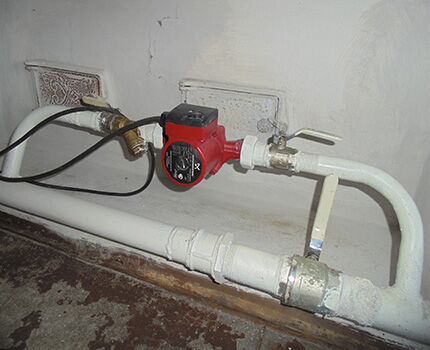
Installation of a bypass pipe (by pass) allows the heating system to operate in the event of a power outage, and also makes it possible to remove the pump without draining the water
Rules for using the expansion tank
The liquid expands when heated, and if this occurs in a closed system, then the pressure inside it will greatly increase, and an increase in pressure is fraught with a breakthrough of water. The use of a safety valve is impractical, since after the water cools down and its volume is reduced, air will be released into the system.
Therefore, in heating circuits with forced movement of water, special expansion tanks are used, which are open or closed. Their volume is calculated based not only on the maximum thermal expansion of the liquid (5-7%), but also taking into account the possibility of the system boiling.
The open-type tank equips the gravity-type furnace heating water circuit, i.e. with natural transportation of the coolant. It is a metal container of arbitrary shape located at the very top of the heating circuit. It communicates directly with the atmosphere, due to which the coolant partially evaporates.
The pipeline is connected to the bottom or the lower quarter of the tank, and a pipe is welded to the top of it to drain water in case of overflow and to release air from the system. Practice shows that the volume of an open tank should be at least 15% of the volume of water in the heating system.
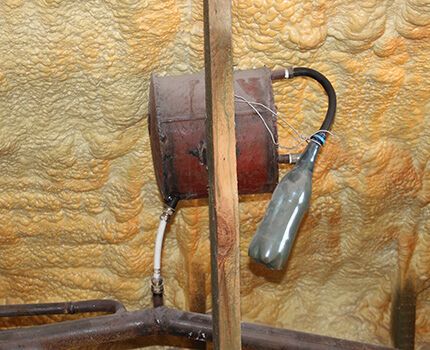
An open-type expander tank is usually located in a technical room and its appearance does not matter.
A closed or membrane type tank is a closed vessel with a membrane inside. When the water heats up, it increases the pressure, stretches the membrane and enters the tank. If the pressure is exceeded, the automatic system is triggered, and the excess coolant is discharged into the sewer. After the first reset, there is usually no more reason to re-produce it, because the volume of the coolant becomes equal to the volume of the system.
A closed diaphragm tank is installed in front of the pump. Such a tank, unlike an open-type tank, cannot get rid of air on its own, therefore, at the top of the heating circuit, it is necessary to install a Mayevsky valve (mechanical air vent) or its automatic analogue. The only element of the membrane tank that can fail over time is the membrane, so it is better to buy a tank with the ability to replace the membrane.
When purchasing a closed-type tank, which is sometimes called a hydraulic accumulator, the main thing is not to confuse it with a hydraulic accumulator for water supply. For a membrane tank, which is used in heating, the operating temperature is up to 120 degrees, and the pressure is up to 3 bar. For water supply, tanks are used with a temperature of up to 70 degrees and a pressure of up to 10 bar.
Choosing between pipes and radiators
A system of plastic pipes with radiators (batteries) or a system of metal pipes can be used as a water circuit for stove heating. The main advantage of using radiators is that they look more beautiful compared to massive air ducts.
The plastic wiring can be easily hidden in the floor, as it does not give off heat. Although, according to the rules, the distribution of water heating should be open. However, polymer pipelines have limitations: they cannot be laid where there is a possibility of reflow and direct UV exposure.
The advantage of metal pipes is the lower cost of the entire heating circuit, ease of installation and less frequent problems during the operation of the system.
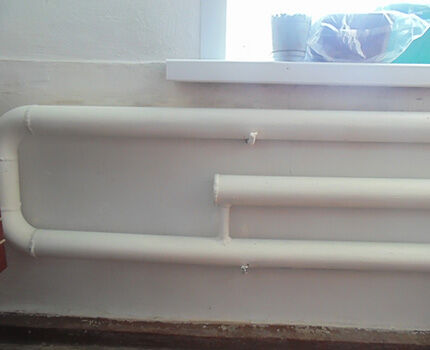
The use of metal heating pipes instead of a radiator system with a metal-plastic liner is justified if the aesthetic component of the room design is not important
A small advantage of the system with radiators is also the ease of temperature control. Even the most accurate room temperature calculations can be adjusted. For example, a small child under 6 months old is recommended a temperature of 19-21 degrees Celsius, while 25 degrees is considered a comfortable temperature in the rest of the house.
To provide such a temperature for a long period of time in the room, it is enough to completely or partially close the tap for supplying heat to one of the radiators. In the case of a metal pipe, the issue can also be solved, but in a more complex way: to reduce the heat transfer of the pipe segment using a polyurethane foam or foil shell.
Another option for the heating circuit can be a water-heated floor. This is a very comfortable type of heat supply for a person, but the installation of a warm floor is much more laborious than the previously considered options.
In addition, when using a warm floor, it is not possible to provide a slope for the natural circulation of water, which, in combination with a small diameter of pipes for a warm floor, leads to an indispensable condition for the use of a circulation pump.
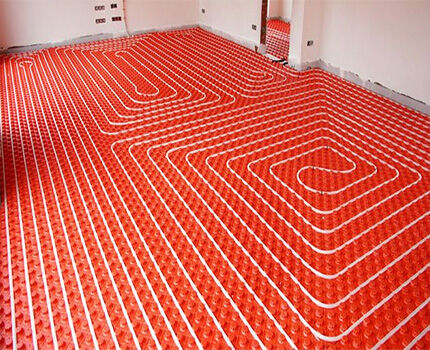
To push water through the pipes of the underfloor heating, it is necessary to use a pump, natural circulation will not work with such a geometry of the heating system
Preventing freezing of the heating system
The use of water as a heat carrier has one drawback - in case of freezing of the heating system, the pipeline and devices will be damaged. In this case, it is especially difficult to restore the heat exchanger integrated in the furnace. This problem is relevant for houses that may not be heated for a long time in winter. One way to prevent damage to the system is to use a heating system antifreeze instead of water.
For residential premises, liquids based on propylene glycol are used as antifreeze, as a non-toxic substance, unlike ethylene glycol.
However, the idea of using antifreeze has its drawbacks:
- antifreeze based on propylene glycol is expensive (from 80 r / liter);
- the specific heat capacity of antifreeze is less than that of water (approximately 15%), therefore, a large furnace power and a large surface area of room heating devices are required;
- antifreeze has a higher dynamic viscosity than water, therefore a more powerful circulation pump is needed, and natural circulation is impossible;
- when heated, the antifreeze expands to 40%, therefore it is necessary to use a large closed-type expansion tank;
- propylene glycol is very fluid, therefore it penetrates through joints in the heating system through which water does not penetrate;
- propylene glycol is incompatible with galvanized pipes, because upon contact, antifreeze additives lose their properties;
- when antifreeze boils (which is likely when using stoves), an irreversible chemical reaction occurs, as a result of which the entire system will have to be drained and antifreeze refilled.
For antifreeze, the heating system must be calculated in advance - its use in projects implemented for water is rather problematic. Moreover, a project using antifreeze will be much more expensive than a hot water heating system. Therefore, the use of antifreeze has not yet become widespread in private houses for stove heating, and other methods are used to prevent freezing.
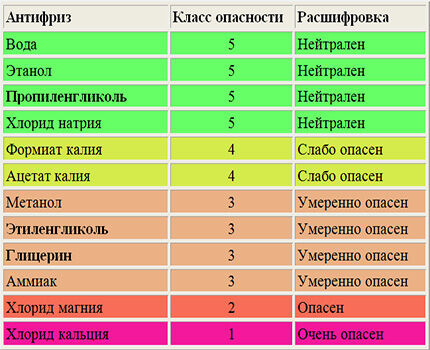
When choosing a liquid for a heating system, it is necessary to keep in mind not only the physicochemical characteristics, but also its danger to others
Drainage of water from the circuit and jacket or register of the stove is the most common solution to the problem in the absence of the owners of the house for a long time. In addition to additional work, the disadvantages of this method include air access to the metal elements of the system from the inside and, as a result, the spread of corrosion.
Also, as a solution to the problem for a short period of time, integration into the heating circuit of an electric boiler of low power is used. Its operation at the minimum level of energy consumption is able to temporarily maintain a positive water temperature.

A low-power electric boiler connected to the heating system is able to maintain a positive water temperature in case of a long absence of owners
Video about the calculation and design of the heating system
Calculation of air heating parameters using the example of a real private house:
Working heating system based on a stove and a water circuit in a private house with an area of 80 square meters:
How to properly install the pump using a bypass pipe:
Heat is supplied to the heating system from stoves and fireplaces in portions, which complicates the task of calculating the parameters of the heating circuit elements. It is quite problematic to carry out work on reworking the circuit, therefore, if there is a lack of experience in this area, it is better to contact specialists who have the skills to solve such problems.








